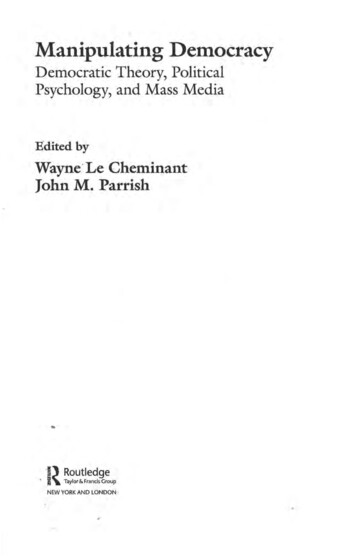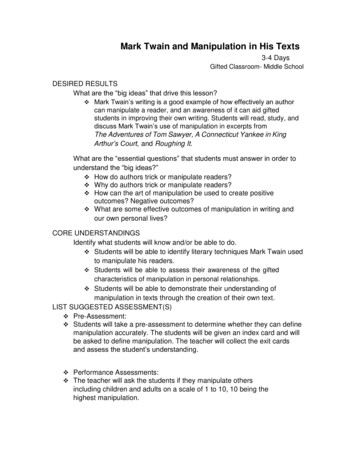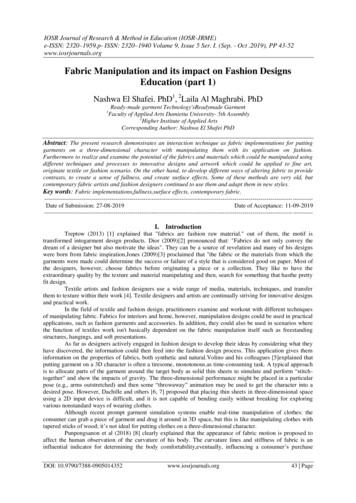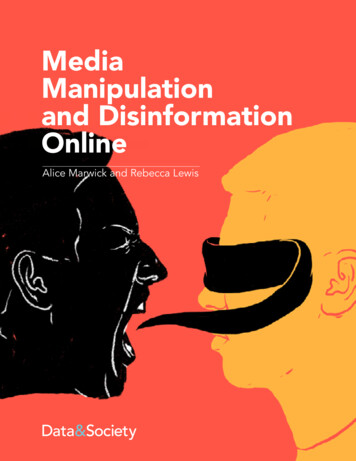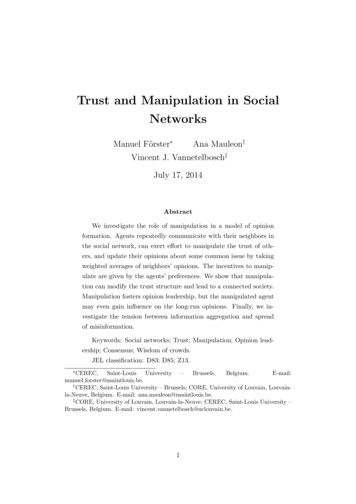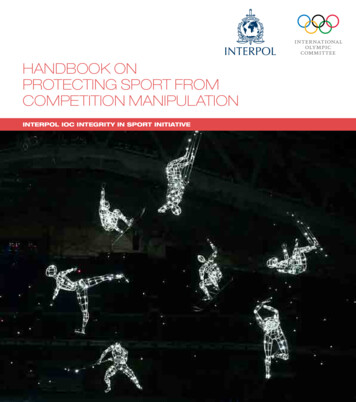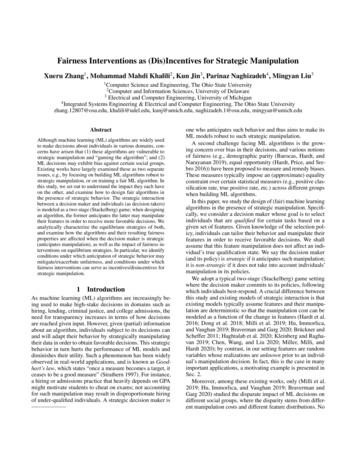
Transcription
ManipulationEducation ManualFor Physical TherapistProfessional Degree ProgramsManipulation Education CommitteeAPTA Manipulation Task ForceJointly sponsored by:Education Section and Orthopaedic Section, American Physical Therapy AssociationAmerican Physical Therapy AssociationAmerican Academy of Orthopaedic Manual Physical Therapists2004
April 2004Dear Physical Therapist Educator,As you know, the practice of physical therapy has been under attack on many fronts recently; one ofthe most aggressive has been directed toward the physical therapist’s ability to provide manualtherapy interventions including nonthrust and thrust mobilization/manipulations. APTA has beenworking with the American Academy of Orthopaedic Manual Physical Therapists (AAOMPT) andthe Education and Orthopaedic Sections of APTA, to develop proactive initiatives to combat theseattacks. In early 2003, strategies were developed to heighten awareness among academic and clinicalfaculty of legislative and regulatory threats to physical therapist use of manipulation in practice and inacademic instruction. One of these strategies is to promote dialogue and resource sharing amongphysical therapy faculty regarding instruction, legislation, and regulation in the area of thrustmanipulation. The Manipulation Education Manual (MEM) was developed to support the ongoingefforts in physical therapist education programs to provide appropriate, evidence-based instruction inthrust manipulation.Educational preparation of physical therapists for the practice of manipulative therapy is often thefocal point of arguments made in legislative and regulatory arenas by those attempting to limit ourability to participate in this area. Clearly, all forms of manual therapy, including all grades ofmobilization and manipulation therapeutic movements, are within the scope of practice of physicaltherapy as is reflected in their inclusion in A Normative Model of Physical Therapist ProfessionalEducation (APTA, 2004), the evaluative criteria of the Commission on Accreditation in PhysicalTherapy Education (CAPTE), and the Guide to Physical Therapist Practice (APTA, 2003). Thesafety and effectiveness of all grades of mobilization/manipulation in physical therapist practice iswell documented in the literature, particularly in the area of acute low back pain management. It isour shared goal that all professional educational programs provide strong education based on soundevidence. The evidence supporting physical therapist utilization of mobilization/ manipulation is welldocumented and underscores the necessity for our profession to be ready to clearly articulate anddemonstrate its incorporation in our educational programs.The enclosed Manipulation Education Manual provides a rich set of resource information that willassist you in enhancing your ongoing curriculum assessment and development in this area. We expectfaculty members to find it a valuable resource in several regards. Academic coordinators of clinicaleducation may wish to share materials in the manual with clinical instructors. Orthopedic facultymembers will likely find the evidence review and curriculum resource information useful in coursedevelopment and other aspects of instruction. Information in the manual will also be useful to facultymembers who may be called to provide testimony or opinion if regulatory or legislative issues arise inyour state. Should you have any questions, please do not hesitate to contact any member of thecommittee or appropriate staff members at APTA.Sincerely,Patricia M King, MA, PT, MTCChair, Manipulation Education CommitteeAPTA Manipulation Task ForceWilliam G Boissonnault, PT, DHSc,FAAOMPTChair, APTA Manipulation Task Force
Table of ContentsBackground . 1Introduction . 1Legislative and Regulatory Background. 2Educational and Practice Standards. 3Evidence Supporting Manipulation in Physical Therapist Education . 3Curriculum Resources. 7Legislative and Regulatory Considerations . 7Curricular Content . 10Manipulation Theory and Principles . 12Practical Instruction–Manipulation Techniques. 13Clinical Education . 13Sample Instructional and Evaluative Materials . 17Course Syllabi Development .17Sample Course Syllabi . 19Practical Instruction. 22Sample Lab Handouts . 25Sample Practical Examinations. 29Instructional Resource List . 35Faculty and Clinical Instructors. 41Recommended Qualifications . 41Professional Development. 42Locating Qualified Faculty and Clinical Instructors . 43Contact List . 44
AcknowledgementsMembers of the APTA Manipulation Education Committee who contributed to the development ofthe Manipulation Education Manual (MEM) were Patricia M. King (chair), William Boissonnault,Dick Erhard, Timothy Flynn, Kenneth Olson, Stanley Paris, Catherine Patla, Robert Rowe, BarbaraSanders, Phil Sizer, Marcie Swift, Robert Wainner, and Melissa Wolff-Burke. Justin Elliott, associatedirector, state relations, of APTA’s State Government Affairs Department, coordinated staff supportof the group’s activities. Individual members’ credentials and contact information are found in theContact List at the end of the manual
BackgroundPurposeThe purpose of this section is to provide an overview of the activities and information that influencedand supported the development of this manual.ContentsIntroductionLegislative and Regulatory BackgroundEducational and Practice StandardsEvidence Supporting Manipulation in Physical Therapist EducationBibliographyIntroductionManipulation Education CommitteeThe Manipulation Education Committee was organized by the American Physical TherapyAssociation’s (APTA) Manipulation Task Force in early 2003. The committee was charged todevelop and initiate strategies to support and facilitate manipulation instruction in professionalphysical therapist education programs and to heighten awareness among academic and clinical facultyof legislative and regulatory issues associated with manipulation.The American Academy of Orthopaedic Manual Physical Therapists (AAOMPT), the OrthopaedicSection, APTA, and the Education Section, APTA, each identified individuals to serve on thecommittee. The Orthopaedic Section and the AAOMPT provided financial support for the activitiesof the committee.The committee first met in June 2003 and agreed to develop a resource packet for academic programsthat provided a broad spectrum of information for faculty on the topic of manipulation instruction. Inaddition, the group identified key groups within the profession to address manipulation instructionsuch as the Academic Administrators Special Interest Group (AASIG) and the Clinical EducationConsortium.Manipulation Education ManualThe Manipulation Education Manual (MEM) and related activities of the Manipulation EducationCommittee and the Manipulation Task Force are in place to support the continued development ofmanipulation instruction in physical therapist education by assisting faculty in their ability to integratethe current best-evidence–based interventions related to manipulation into educational activities. Thespecific purpose of the MEM is to provide resource information to assist faculty in curriculumplanning and academic and clinical teaching related to manipulation.The Manipulation Education Committee developed the MEM based on the evidence-supportedassumption that the inclusion of spinal and extremity mobilization/manipulation in the curriculum ofprofessional physical therapist education programs is appropriate, safe, and ethical. The entirecontinuum of manipulative procedures, including thrust manipulations, is appropriate for inclusion inthe curriculum of professional physical therapist education programs. Evidence for the safety andeffectiveness of manipulation in physical therapist practice and education is clear and is reviewed inthe latter part of this section of the manual. Compliance with current physical therapist education1
program standards as described in A Normative Model of Physical Therapist Professional Education1and practice standards (Guide to Physical Therapist Practice)2 make it clear that these interventionsare appropriate curricular components of physical therapist education.The committee utilized the following definitions of manual therapy and mobilization/manipulationfrom the current Guide to Physical Therapist Practice and endorses their use in professionaleducation and practice.2Mobilization/manipulation: A manual therapy technique comprising a continuum ofskilled passive movements to the joints and/or related soft tissue that are applied atvarying speeds and amplitudes, including a small-amplitude/ high- velocity therapeuticmovement.The terms manipulation and mobilization are used interchangeably in this document.3 The committeedefined thrust manipulation as “high velocity, low amplitude therapeutic movements within or at endrange of motion.” (Manipulation Education Committee, June 2003)Legislative and Regulatory BackgroundSince 1993, at least 30 state chapters of APTA have had to defend the right of licensed physicaltherapists to practice manual therapy. The professional education preparation of physical therapists inthe area of manipulation is frequently a focal point of arguments put forward by those attempting toremove our right to practice in this area. Therefore, to maintain manipulation as a vital part of thescope of physical therapist practice, physical therapists must be able to demonstrate to legislators thatthe entire continuum of manipulation procedures are taught as part of the professional educationcurriculum. Our educational standards as well as our practice guidelines clearly include manipulation.Faculty members are often called upon to provide testimony regarding the education and practicestandards for manipulation in physical therapist professional education. One of the goals ofdistributing this manual is to heighten awareness among faculty of the integral role professionaleducation often plays in legislative and regulatory challenges to manipulation practice.Additional resources to assist faculty and others in preparing a defense of the position thatmanipulation is within the scope of physical therapist practice can be obtained by contacting theAPTA State Governmental Affairs Department (ask for the APTA Manipulation Action Packet) andthe APTA Orthopaedic Section (ask for Manual Manipulative Therapy: A Compendium for PhysicalTherapists Regarding Practice and Legislative Issues). Much of the information provided in theaforementioned resources may also be useful to faculty in the development of instructional materials.Regulatory issues that need to be considered when teaching manipulation in physical therapistprofessional education programs are addressed later in this manual in the Curriculum Resourcessection (page 11).Educational and Practice StandardsManual therapy, including mobilization/manipulation, has been a component of physical therapistpractice since the inception of the profession.4 The Guide to Physical Therapist Practice makes itclear that manipulation is within the scope of physical therapy practice.2 A Normative Model ofPhysical Therapist Professional Education: Version 20041 includes mobilization/manipulation as anintervention that should be taught in professional physical therapist education. In addition, manualtherapy techniques (including manipulation) is a content area currently required by CAPTE to beincluded in professional physical therapist education programs.5 While survey data shows thatmobilization/manipulation in some form has been included in professional physical therapist curriculasince at least the 1970s and has steadily increased, 6 a recent survey suggests that wide variation existsas to the how this content is integrated into physical therapist curricula.72
Evidence Supporting Manipulation in Physical TherapistEducation CurriculumIn this era of medical cost cutting, reimbursement agencies and other interested parties are demandingevidence-based interventions. Manipulation is a safe and effective clinical intervention, and its safetyand effectiveness are not dependent upon the profession of the practitioner applying it or the specifictechniques used. Although manipulation has been practiced since the era of Hippocrates, onlyrecently has external evidence in the form of randomized clinical trials supported the safety andefficacy of manipulation.8 Notably, much of the research supporting the use of spinal manipulationhas been conducted by physical therapists.8,9Evidence Regarding Manipulation EffectivenessThe strongest and most voluminous support for the safe and effective use of manipulation is in themanagement of patients with acute low back pain (LBP). Spinal manipulation received the highestlevel of evidence awarded any intervention in the 1994 Agency for Health Care Policy and Research(AHCPR) Guidelines, which was the first clinical practice guideline to recommend the use ofmanipulation in the care of acute LBP.8 Since then, a number of other clinical practice guidelines(based on the results of randomized clinical trials and systematic reviews) have been published byvarious independent agencies with the same conclusion: spinal manipulation is a safe, effective, andrecommended intervention in the management of LBP. A summary of the specific findings andrecommendations of these can be found on the Web sites listed in the bibliography.3,10,11 Although theresults of a recent systematic review were not as strong as the previously mentioned guidelines,12research continues and the findings of a recently concluded high-quality clinical trial promises toprovide the strongest evidence yet for efficacy.13 There is also mounting evidence for the use ofmanipulation in the management of patients with pain in other spinal regions as well as theextremities,14,15,16 although the strength of conclusions about efficacy is not as strong as that for acuteLBP at this time.Epidemiological research shows that individuals with lumbo/pelvic, cervical, shoulder, and kneesprains/strains/conditions represent the largest segment of the patient population seeking outpatientphysical therapy services.17,18,19,20 Research supports the utilization of manipulation for each of thesediagnostic groups. The number of graduates expected to work in outpatient settings supports theinclusion of manipulation in the didactic and clinical education experiences of physical therapiststudents.Evidence Regarding Manipulation SafetyThere is considerable evidence for the safety and effectiveness of manipulation for the treatment ofpatients with acute low back pain. The risk of cauda equina syndrome from lumbar manipulation hasbeen estimated to be on the order of 1 in 100 million manipulations,21 whereas the risks associatedwith nonsteroidal anti-inflammatory drugs, the most common competing drug therapy, is many ordersof magnitude higher. Indeed, the risk of serious gastrointestinal bleeding from nonsteroidal antiinflammatory drugs is 1-3 per 1000 and an estimated 76,000 hospitalizations and 7600 deaths (peryear) may be attributable to these medications.9,22 While there is concern about the use of thrusttechniques in the cervical spine, serious complications are still extremely rare (estimated to rangefrom 1 per 400,000 to 3-6 per 10 million)23,24 and unlike the lumbar spine literature, a number ofreports indicate that nonthrust cervical spine manipulation techniques may be just as effective.14 Noreports of complications exist attributing harm from manipulation of the extremities. As stated byGordon Waddell, “Orthodox medicine has a long way to go to reduce the rate of seriouscomplications to the order of 1:0.2-1 million. What matters is the balance of the effectiveness versusrisk, and that is strongly in favor of manipulation.”253
Unfortunately, having evidence that is available does not always result in its implementation. Despitethe high number of patients with low-back pain managed by physical therapists in outpatientorthopedic settings, reports of practice patterns both in the US and abroad suggest that spinalmanipulation is underutilized by physical therapists.26,27 Delitto accurately summarizes the currentstate of affairs regarding manipulation: “Over the past 10 years, for example, we have seen some verycompelling evidence supporting manipulation for patients with acute LBP, yet manipulation is usedby physical therapists in typical outpatient settings at a lower-than-expected rate. What seems to beincontrovertible is the fact that evidence exists to support the use of certain treatment procedures forpatients with LBP and, like other health care professionals, physical therapists' behavior, in manycases does not comply with such guidelines.”28SummaryIn summary, well-designed research has generated evidence supporting the safety and effectiveness ofmanipulation in physical therapist practice. Evidence is also available supporting the safety andeffectiveness of manipulation instruction in the first phase of physical therapist professionaleducation.29 Physical therapist educational and practice standards support and clarify the inclusion ofthis intervention in professional education. Considering these facts, physical therapist students mustbe prepared with the knowledge and skills to practice manipulation if they are expected to practice inan evidence-based manner.References1.A Normative Model of Physical Therapist Professional Education: Version 2004. Alexandria, Va: American PhysicalTherapy Association; 2004.2. Guide to Physical Therapist Practice, Revised 2nd Ed. Alexandria, Va: American Physical Therapy Association; 2003.3. DoD/VA Low Back Pain Guidelines. Edited, DoD/VA, 1999. Available at: http://www.qmo.amedd.army.mil/lbpfr.htm.4. Paris S. A history of manipulative therapy through the ages and up to the current controversy in the United States. JManual Manipulative Ther. 2000;8(2):66-77.5. Commission on Accreditation in Physical Therapy Education. Evaluative criteria for the accreditation of educationprograms for the preparation of physical therapists. Alexandria, Va: American Physical Therapy Association; 1998.6. Bryan JM, McClune LD, Romito S, Stetts DM, Finstuen K. Spinal mobilization curricula in professional physicaltherapy education programs. J Phys Ther Educ, 1997;11:11-15.7. Boissonnault W, Bryan JM, Fox K. Manipulation curricula in physical therapist professional degree programs. JOrthop Sports Phys Ther. 2004:34(4):171-181.8. Bigos S et al. Acute Low Back Problems in Adults. Edited by the Agency for Health Care Policy and Research, PublicHealth Service. , Rockville, Md: US Department of Health and Human Services, 1994.9. Tamblyn R et al., Unnecessary prescribing of NSAIDs and the management of NSAID-related gastropathy in medicalpractice. [see comments]. Ann Int Med. 1997;127(6):429-438.10. New Zealand Acute Low Back Pain Guide. Edited, Wellington, NZ, ACC, and National Health Committee, 1997.Available at: http://www.nzgg.org.nz/library/gl complete/backpain1/index.cfm#contents.11. Waddell G, Feder G, McIntosh A,. Low Back Pain Evidence Review. Edited, London, Royal College of GeneralPractitioners, 1999. ckpain/backpain5.asp#Guideline.12. Assendelft WJ, Morton SC, Yu EI, Suttorp MJ, Shekelle PG. Spinal manipulative therapy for low back pain. A metaanalysis of effectiveness relative to other therapies [summary for patients in Ann Intern Med. 2003 Jun 3;138(11):I33;PMID: 12779310]. Ann Int Med. 2003;138(11):871-881.13. Childs J, Fritz JM, Flynn TW, Irrgang JJ, Delitto A, Johnson KK, Majkowski G. Validation of a clinical prediction ruleto identify patients likely to benefit from spinal manipulation: a randomized clinical trial. (In review).14. Hoving JL, et al. Manual therapy, physical therapy, or continued care by a general practitioner for patients with neckpain. A randomized, controlled trial [summary for patients in Ann Intern Med. 2002 May 21;136(10):I36; PMID:12020157]. Ann Int Med. 2002;136(10):713-722.15. Ingeborg BC, et al. Cost effectiveness of physiotherapy, manual therapy, and general practitioner care for neck pain:economic evaluation along a randomized controlled trial. BMJ. 2003;326.16. Wainner RS, Flynn TW, Whitman JW. Spinal and extremity manipulation: the basic skill set for physical therapists;integrating technical application with the current best evidence. Fort Collins, Colo: Manipulations Inc; 2001. Availableat: t/s/59946.17. Boissonnault WG. Prevalence of comorbid conditions, surgeries, and medication use in a physical therapy outpatientpopulation: a multicentered study. J Orthop Sports Phys Ther. 1999;29:506-519.4
18. Di Fabio RP, Boissonnault W. Physical therapy and health-related outcomes for patients with common orthopaedicdiagnoses. J Orthop Sports Phys Ther. 1998;27:219-230.19. Jette AM, Davis KD. A comparison of hospital-based and private outpatient physical therapy practices. Phys Ther.1991;71:366-375.20. Jette AM, Smith K, Haley SM, Davis KD. Physical therapy episodes of care for patients with low back pain. Phys Ther.1994;74:101-110.21. Shekelle PG, Adams AH, Chassin MR, Hurwitz EL, Brook RH. Spinal manipulation for low-back pain. [seecomments]. Ann Int Med. 1992;117(7):590-598.22. Tannenbaum H, et al. An evidence-based approach to prescribing NSAIDs in musculoskeletal disease: a Canadianconsensus. Canadian NSAID Consensus Participants. [see comments]. CMAJ. 1996;155(1):77-88.23. Haldeman S, Kohlbeck FJ, McGregor M. Risk factors and precipitating neck movements causing vertebrobasilar arterydissection after cervical trauma and spinal manipulation. Spine.1999;24(8):785-794.24. Hurwitz EL, Aker PD, Adams AH, Meeker WC, Shekelle PG. Manipulation and mobilization of the cervical spine. Asystematic review of the literature. Spine. 1996;21(15):1746-1760.25. Waddell G. Evidence for manipulation is stronger than most orthodox medical treatments. BMJ. 1999;318:262.26. Gracey JH, McDonough SM, Baxter GD. Physiotherapy management of low back pain: a survey of current practice inNorthern Ireland. Spine. 2002;27(4):406-411.27. Jette AM, Delitto A. Physical therapy treatment choices for musculoskeletal impairments. Phys Ther. 1997;77(2):145154.28. Delitto A. Clinicians and researchers who treat and study patients with low back pain: are you listening? Phys Ther.1998;78(7):705-707.29. Flynn T, Wainner R, Fritz J. Spinal manipulation in professional level physical therapist education: changing behaviorsand monitoring outcomes in the management of low back pain—a case report. Phys Ther, In Review, 2003.Other Resources1.2.Cohen E, Triano JJ, McGregor M, Papakyriakou M. Biomechanical performance of spinal manipulation therapy bynewly trained vs. practicing providers: does experience transfer to unfamiliar procedures? J Manipulative Physiol Ther.1995;18:347-352.Flynn TW. Move it and move on. J Orthop and Sports Phys Ther. 2002;32:192-193.5
6
Curriculum ResourcesPurposeThe purpose of this section is to provide information that academic administrators, academic faculty,and clinical faculty can use in the development of curricula, courses, and instructional activitiesrelated to manipulation.An overview of legislative and regulatory issues relevant to manipulation instruction in both theacademic and clinical education components of physical therapist professional education is presentedat the beginning of this section. Recommended curricular content related to manipulation in didactic,practical, and clinical education components of educational programs is then presented. Sampleinstructional materials and an instructional resource list are also provided. Recommendations forfaculty qualifications, opportunities for faculty development, and resources for identifying qualifiedfaculty are included as well.By design, thrust manipulation is the focus of the curricular content recommendations presented hereconsistent with the purpose of this manual. Manipulation is one of many evidence-based interventionsphysical therapists may select to utilize. The emphasis on manipulation in the curricular informationin this manual does not imply that it is the sole intervention of choice for physical therapists, or that itshould be used in practice in isolation from other interventions. Manipulation is an intervention withstrong evidence for its efficacy, given the appropriate patient/client history and findings, however inphysical therapist practice its utilization is integrated with other interventions. The best choices forinstructional activities for physical therapists students are those that offer the students opportunity todevelop clinical decision-making skills in the integration of manipulation with other interventions aswell as to develop technical skill in the application of manipulative procedures.ContentsLegislative and Regulatory ConsiderationsCurricular ContentSample Instructional and Evaluative MaterialsCourse Syllabi DevelopmentPractical InstructionInstructional Resource ListFaculty and Clinical InstructorsLegislative and Regulatory ConsiderationsPurposeThe purpose of this section is to provide an overview of current and ongoing legislative andregulatory considerations relevant to academic and clinical instruction in manipulation techniques inprofessional physical therapist degree programs.ContentsScope of Practice RegulationClassroom and Clinical Physical Therapist Laboratory InstructionClinical Internship ConsiderationsSummaryThe primary regulatory consideration in teaching manipulation in physical therapist professionaleducation programs is language related to the use of manipulation by physical therapists in statephysical therapy practice acts and in physical therapist licensing board’s rules and regulations. Other7
standards to be considered are CAPTE’s evaluative criteria,1 the accepted physical therapy scope ofpractice as defined in APTA documents including the Guide to Physical Therapist Practice2 and ANormative Model of Physical Therapist Professional Education,3 and academic freedom rights ofuniversity faculty.Scope of State Practice RegulationThe physical therapist scope of practice is regulated by each state legislature through the passage andregulation of the physical therapy state practice act. Typically, each state practice act includeslanguage that requires the individuals licensed under the physical therapy practice act to be of goodmoral character, to have graduated from a program accredited by a nationally recognized agency oran agency approved by the state board, and to pass the physical therapy licensure examination.Classroom and Clinical Physical Therapist Laboratory InstructionThe focus of classroom and clinical physical therapy laboratory instruction is in accordance withmeeting CAPTE’s evaluative criteria1 that includes teaching the scope of physical therapy practice asdescribed in the Guide, Part I: A Description of Patient/Client Management. The terminology usedand defined in the Guide2 is taught and used in physical therapist professional education programs.Regarding manual therapy, this includes nonthrust and thrust mobilization/manipulationinterventions.State and federal laws of free speech and academic freedom also protect academic faculty members.Consultation with university legal counsel regarding the rights and privileges of university faculty isadvisable if there are any concerns regarding freedom to include certain aspects of the scope ofphysical therapist practice in the professional curriculum due to restrictive language in state practicelaws and/or regulations.Clinical Internship ConsiderationsClinical internship experiences of student physical therapists are under the direct supervision
manipulation in the care of acute LBP.8 Since then, a number of other clinical practice guidelines (based on the results of randomized clinical trials and systematic reviews) have been published by various independent agencies with the s
